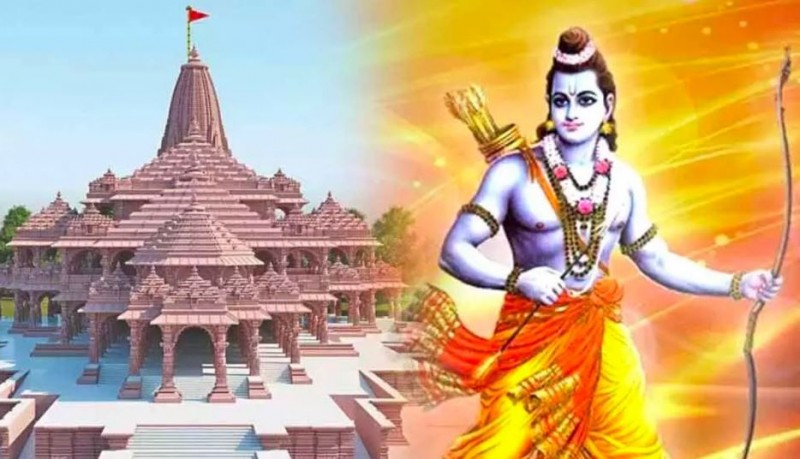
Ayodhya, the ancient city known for its historical and religious significance, has been at the center of a long-standing dispute over the birthplace of Lord Rama. The city, believed to have been founded by Manu, the son of the sun god Vivasvan, is steeped in the lore of the Solar Dynasty (Suryavanshi) rulers who governed the kingdom until the Mahabharata era. The magnificent city, described in Valmiki's Ramayana, is compared to a celestial abode by the sage Valmiki himself.
Birth of Lord Rama in Ayodhya:
The iconic Dasha-rath Mahal in Ayodhya is the site where Lord Rama, the seventh incarnation of Lord Vishnu, was born. The city's unparalleled charm, adorned with jewels and exquisite architecture, is vividly portrayed in the Ramayana. Valmiki, the revered sage, likened Ayodhya to a second heaven while extolling its beauty.
Cycles of Destruction and Reconstruction:
Despite its illustrious past, Ayodhya faced periods of desolation, notably after Lord Rama's departure to the heavenly abode following his earthly sojourn. According to legends, Rama's son, Kush, played a pivotal role in rebuilding Ayodhya after its initial decline. The city flourished for 44 generations of the Solar Dynasty before witnessing another period of devastation post the Mahabharata era.
Challenges and Invasions:
Ayodhya, the birthplace of Lord Rama, and the revered site of the Shri Rama Mandir, faced numerous challenges throughout history. Mughal rulers, including Babur, initiated campaigns to subjugate the city. The construction of the Babri Masjid atop the disputed site marked a significant chapter in Ayodhya's history. The grand temple was demolished, leading to the complex and contentious Ayodhya dispute.
Ayodhya Dispute:
The Ayodhya dispute, spanning over 500 years, became a landmark case in Indian history. The construction of the Babri Masjid in 1528 by Mughal emperor Babur's general Mir Baqi intensified tensions. The contentious site, believed by Hindus to be the birthplace of Lord Rama, witnessed clashes, legal battles, and political maneuvering over the centuries.
Key Events in the Ayodhya Dispute:
1853-1949: Communal tensions erupted around the disputed site, leading to the installation of barriers by the British administration.
1949: Controversy arose when idols of Lord Rama were discovered inside the Babri Masjid, sparking a legal and religious debate.
1992: The demolition of the Babri Masjid by Hindu activists triggered widespread communal violence across India.
2019: The Supreme Court delivered a historic verdict, granting the disputed land for the construction of the Shri Rama Mandir.
Legal Proceedings and Settlement:
The legal journey of the Ayodhya dispute included multiple court hearings and landmark judgments. The Allahabad High Court in 2010 divided the disputed land among Sunni Waqf Board, Nirmohi Akhara, and the deity Ram Lalla. In 2019, the Supreme Court delivered a final verdict, allocating the entire disputed land for the construction of the Ram Mandir and providing separate land to the Sunni Waqf Board.
Construction of the Ram Mandir:
Following the Supreme Court's verdict, the construction of the grand Ram Mandir in Ayodhya commenced. The foundation stone was laid on August 5, 2020, in a ceremony attended by Prime Minister Narendra Modi. The temple, spanning 2.77 acres, stands as a symbol of cultural and religious harmony.
Culmination: Abhishek and Inauguration:
The grand consecration ceremony, known as Abhishek, for the Ram Mandir is scheduled for January 22, 2024. This auspicious occasion, filled with devotion and celebration, marks the culmination of nearly 500 years of anticipation and struggle. The inauguration, scheduled for January 24, 2024, will be officiated by Prime Minister Narendra Modi, signifying the formal opening of the Ram Mandir to the public.
Ayodhya's journey from a city of ancient splendor to the epicenter of a prolonged dispute and, finally, the site of the grand Ram Mandir signifies a profound chapter in India's history. The resolution of the Ayodhya dispute and the construction of the Ram Mandir stand as testaments to the resilience of faith and the ability to transcend historical divisions. The inauguration of the Ram Mandir heralds a new era, where Ayodhya's sacred landscape is restored and open to devotees from across the world.
DRDO Successfully Tests Next-Gen AKASH Missile in Coastal Odisha
Agniveers Integration: General Pande Confirms Success in Army Deployment
Heavy Fog Disrupts Train Services with Over 20 Service Delays En Route to Delhi